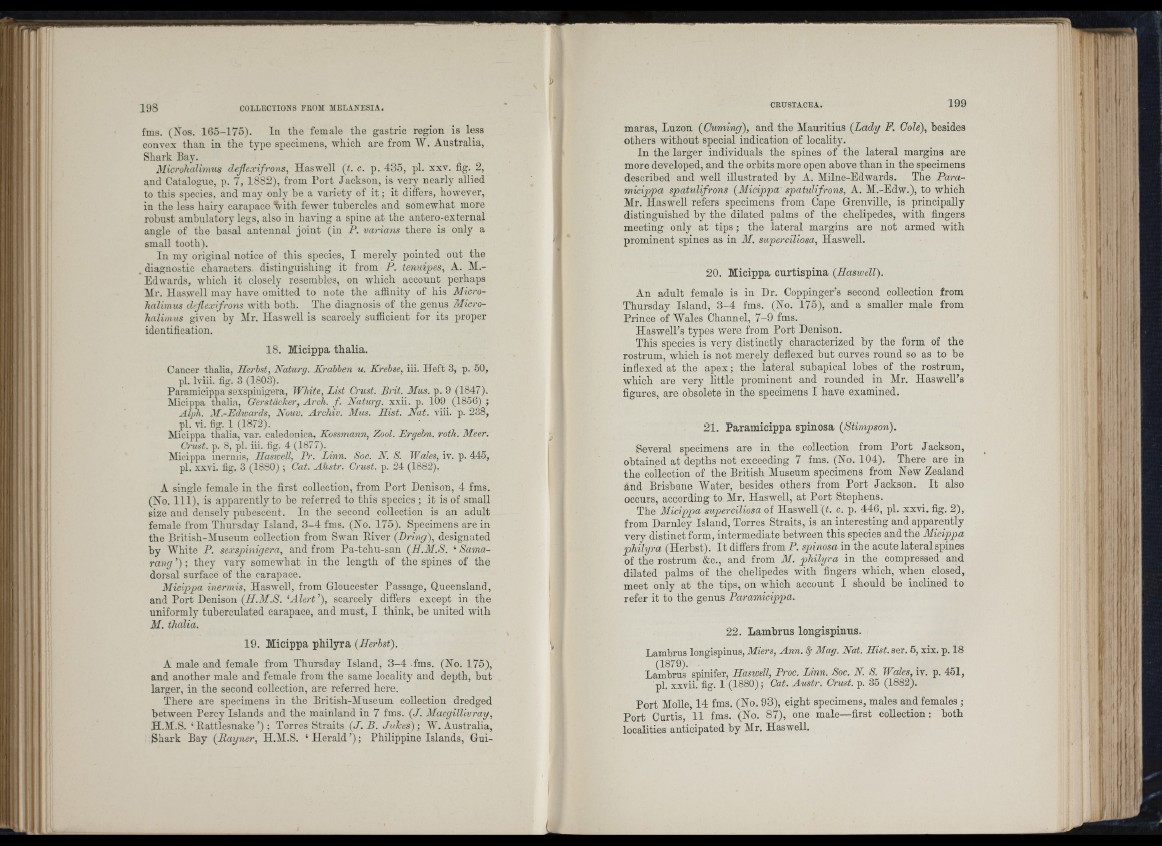
COLLECTIONS FROM MELANESIA.
;
" I i
fms. (Nos. 165-175). In the female the gastric region is less
convex than in the type specimens, which are from W. Australia,
Shark Bay.
Microhalimus deflexifrons, Haswell (i. c. p. 435, pi. xxv. fig. 2,
and Catalogue, p. 7, 1882), from Port Jackson, is very nearly allied
to this species, and may ouly be a variety of i t ; it differs, however,
in the less hairy carapace Vith fewer tubercles and somewhat more
robust ambulatory legs, also in having a spine at the antero-extcrnal
angle of the basal antennal joint (in P. varians there is only a
small tooth).
In my original notice of this species, I merely pointed out the
diagnostic characters, distinguishing it from F. tenuipes, A. Al.-
Edwards, which it closely resembles, on which account perhaps
All'. Haswell may have omitted to note the affinity of his Microhalimus
dejlexifrons with both. The diagnosis of the genus Microhalimus
given by Air. Haswell is scarcely sufficient for its proper
identification.
18. Micippa thalia.
Cancer thalia, Herhst, Naturg. Krahhen u. Krehse, iii. Heft 3, p. 50,
pi. Iviii. fig. 3 (1803).
Paramicippa sexspiuigera, White, List Crust. Brit. AIus. p. 9 (1847).
Micippa thalia, Gerstdcker, Arch. f . Naturg. xxii. p. 109 (1856) ;
Alph. M.-Edivards, Nouv. Archiv. AIus. Hist. Nat. viii. p. 238,
pi. vi. fig. 1 (1872).
Alicippa thalia, var. caledouica, Kossmann, Zool. Ergehn. roth. Meer.
Crust, p. 8, pi. iii. fig. 4 (1877).
Alicippa inermis, Hasivell, Pr. Linn. Soc. N. S. Wales, iv. p. 445,
pi. xxvi. fig. 3 (1880) ; Cat. AUstr. Crust, p. 24 (1882).
A single female in the first collection, from Port Denison, 4 fms.
(No. I l l ) , is apparently to be referred to this species ; it is of small
size aud densely pubescent. In the second collection is an adult
female from Thursday Island, 3 -4 fms. (No. 175). Specimens are in
the British-Aluseum collection from Swan Eiver (Dring), designated
by AA’hite P. sexspinigera, and from Pa-tchu-san (H.M.S. ‘ Samara
n g ’)-, they vary somewhat in the length of the spines of the
dorsal surface of the carapace.
Alicippa inermis, Haswell, from Gloucester Passage, Queensland,
and Port Denison (H.Al.S. '■Alert ’), scarcely differs except in the
uniformly tuberculated carapace, and must, I think, be united with
ilf. thalia.
19. Micippa philyra (Herhst).
A male and female from Thursday Island, 3 -4 .fms. (No. 175),
and another male and female from the same locality and depth, but
larger, in the second collection, are referred here.
There are specimens in the British-Aluseum collection dredged
between Percy Islands and the mainland in 7 fms. (J. Macgillivray,
H.Al.S. ‘Rattlesnake’) ; Torres Straits (J. B . Jukes)-, W. Australia,
Shark Bay (Bayner, H.Al.S. ‘ Herald ’) ; Philippine Islands, Gui-
« Í
-i I
maras, Luzon (Cuming), and the Mauritius (Lady F. Cole), besides
others without special indication of locality.
In the larger individuals the spines of the lateral margins are
more developed, and the orbits more open above than in the specimens
described and weU illustrated by A. Alilne-Edwards. The Paramicippa
spatulifrons (Alicippa spatulifrons, A. AI.-Edw.), to which
Mr. Haswell refers specimens from Cape Grenville, is principally
distinguished by the dilated palms of the chelipedes, with fingers
meeting only at tip s ; the lateral margins are not armed with
prominent spines as in AI. superciliosa, Haswell.
20. Micippa curtispina (Haswell).
An adult female is in Dr. Coppinger’s second collection from
Thursday Island, 3 -4 fms. (No. 175), and a smaller male from
Prince of AVales Channel, 7-9 fms.
Haswell’s types were from Port Denison.
This species is very distinctly characterized by the form of the
rostrum, which is not merely deflexed but curves round so as to he
inflexed at the apex; the lateral subapical lobes of the rostrum,
which are very little prominent and rounded in Air. Haswell’s
figures, are obsolete in the specimens I have examined.
l l h h n
■ !•
!
21. Paramicippa spinosa (Stimpson).
Several specimens are in the collection from Port Jackson,
ohtained at depths not exceeding 7 fms. (No. 104). There are in
the collection of the British Museum specimens from New Zealand
and Brisbane Water, besides others from Port Jackson. I t also
occurs, according to Air. Haswell, at Port Stephens.
The Alicippa sup>erciliosa of Haswell (t. c. p. 446, pi. xxvi. fig. 2),
from Darnley Island, Torres Straits, is an interesting and apparently
very distinct form, intermediate between this species and the Micippa
philyra (Herhst). I t differs from P. spnnosa in the acute lateral spines
of the rostrum &c., and from AI. philyra in the compressed and
dilated palms of the chelipedes with fingers which, wheu closed,
meet only at the tips, on which account I should be inclined to
refer it to the genus Paramicippa.
'IM:
!l ,
■!; I
H!IIjIt !j
( i V
, P '
22. Lamhrus longispinus.
Lamhrus longispinus, Miers, Ann. ^ Mag. Nat. Hist. ser. 5, xix. p. 18
(1879).
Lamhrus spinifer, Haswell, Proc. Linn. Soc. N. S. Wales, iv. p. 451,
pi. xxvii. fig. 1 (1880); Cat. Austr. Crust, p. 35 (1882).
Port Molle, 14 fms. (No. 93), eight specimens, males and females ;
Port Curtis, 11 fms. (No. 87), one male—first collection: both
localities anticipated by Mr. Haswell.
frl Ì ¡